Box Tree Moth
In August 2018, box tree moth (Cydalima perspectalis) was detected by a citizen scientist in Toronto on an online publication iNaturalist. This marks the first confirmed detection of this potentially destructive invasive insect in North America.
En août 2018, la pyrale du buis a été détectée par un citoyen de Toronto et a publié la détection de ce papillon de nuit dans une publication en ligne iNaturalist. Ceci marque la première détection confirmée de cet insecte envahissant potentiellement destructeur en Amérique du Nord.
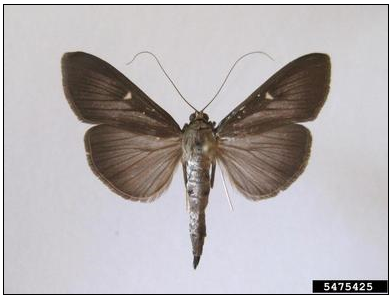
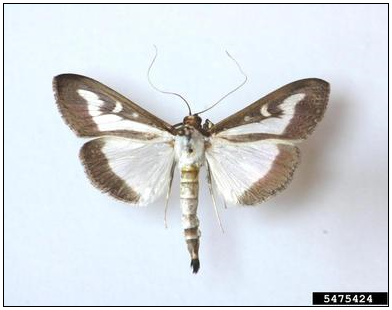
Two adult colour variants have been recognized; the more common variant has white wings with thick dark brown borders while the less common form has brown wings with a small white streak on the forewing. (Szablocs Sáfián, University of West Hungary, Bugwood.org)
Deux variantes de couleur ont été reconnues chez l’adulte; la variante plus commune a des ailes blanches avec d’épaisses bordures brun foncé tandis que la forme moins commune a des ailes brunes avec une petite rayure blanche sur la partie antérieure. (Szablocs Sáfián, University of West Hungary, Bugwood.org)
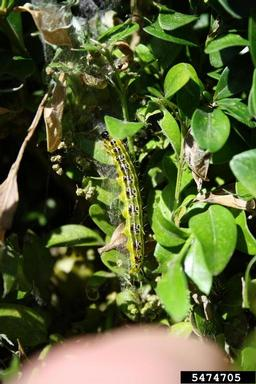
Larva are light green in colour with characteristic black stripes, white dots and a black, shiny head. (Ferenc Lakatos, University of Soporn, Bugwood.org)
La chenille est de couleur vert clair avec des rayures noires caractéristiques, des points blancs et une tête noire et brillante. (Ferenc Lakatos, University of Soporn, Bugwood.org)
Quick Facts
- Box tree moth, Cydalima perspectalis, is an invasive insect native to Eastern Asia threatening Europe and North America.
- In Canada, the box tree moth was detected near Toronto, Ontario in 2018.
- Most damage occurs as the hatched larvae feed on the boxwood, skeletonizing the leaves, causing defoliation and dieback.
- It is considered invasive throughout Europe, first detected in Germany and Netherlands.
- This species poses a major threat to planted boxwood, a common horticultural shrub in Canada.
Faits rapides
- La pyrale du buis, Cydalima perspectalis, est un insecte envahissant originaire d’Asie orientale qui menace l’Europe et l’Amérique du Nord.
- Au Canada, la pyrale du buis a été détectée près de Toronto, en Ontario, en 2018.
- La plupart des dommages se produisent lorsque les larves se nourrissent du buis, squelettisant les feuilles, provoquant une défoliation et un dépérissement.
- Elle est considérée comme envahissante dans toute l’Europe, et a d’abord été détectée en Allemagne et aux Pays-Bas.
- Cette espèce représente une menace majeure pour le buis planté, un arbuste horticole commun au Canada.
Stop the Spread
- Raising public awareness on the risk of moving infested boxwood material is essential to help control and limit the spread of C. perspectalis in Canada.
- Learn to identify this species and the signs and symptoms of its presence.
- The insect can be picked off by hand, or in some cases, a pheromone trap can be used for control.
- Report all potential detections to the CFIA, or report them to EDDMapS.
Aidez à arrêter la propagation!
- Il est essentiel de sensibiliser le public au risque de déplacement de matériel de buis infesté pour aider à contrôler et à limiter la propagation de C. perspectalis au Canada.
- Apprennez à identifier cette espèce et les signes et les symptômes de sa présence.
- L’insecte peut être ramassé à la main ou, dans certains cas, un piège à phéromone peut être utilisé pour le contrôle.
- Signalez toutes les détections potentielles à l’ACIA ou signalez-les à EDDMapS.
European Cherry Fruit Fly
On June 27, 2016, the presence of European cherry fruit fly (Rhagoletis cerasi) was confirmed in an urban park in Mississauga, Ontario. This marks the first confirmed detection of this potentially destructive invasive insect in North America.
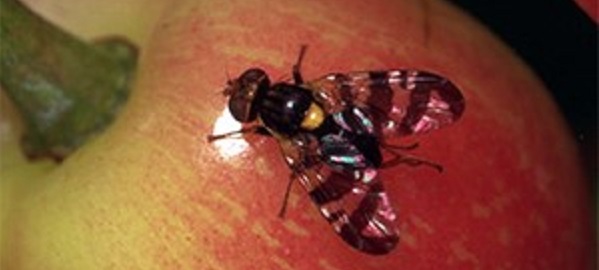
Quick Tips
- The insect, which attacks cherry fruit and renders it unacceptable for fresh consumption, is a pest regulated by both Canada and the United States (US) and has never been reported in North America until now.
- The pest poses no threat to human health
- To date, the pest has not been reported in association with cherry production in Ontario
- The CFIA is completing a survey and working with its partners to determine the extent of the pest’s distribution
Prevent the Spread
- Learn to identify this species and the signs and symptoms of its presence
- Report all potential detections to the CFIA – Call 1-800-442-2342 or contact your local CFIA office
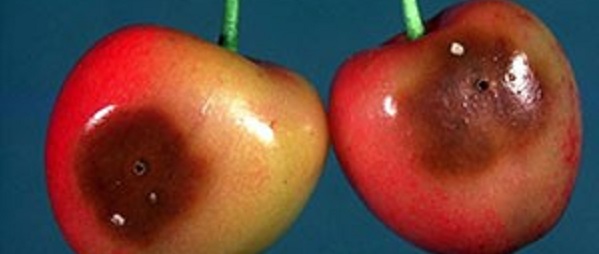
Map the Invasive Host
In addition to Prunus spp. (cherries), the European cherry fruit fly attacks Lonicera spp. (honeysuckle). Some species of honeysuckle are invasive to Ontario, and can be found throughout the province. Help map the distribution of this invasive shrub on EDDMapS Ontario – this can inform experts of areas that may be at high risk for European cherry fruit fly invasion! (Photo: Chris Evans, Illinois Wildlife Action Plan, Bugwood.org)
